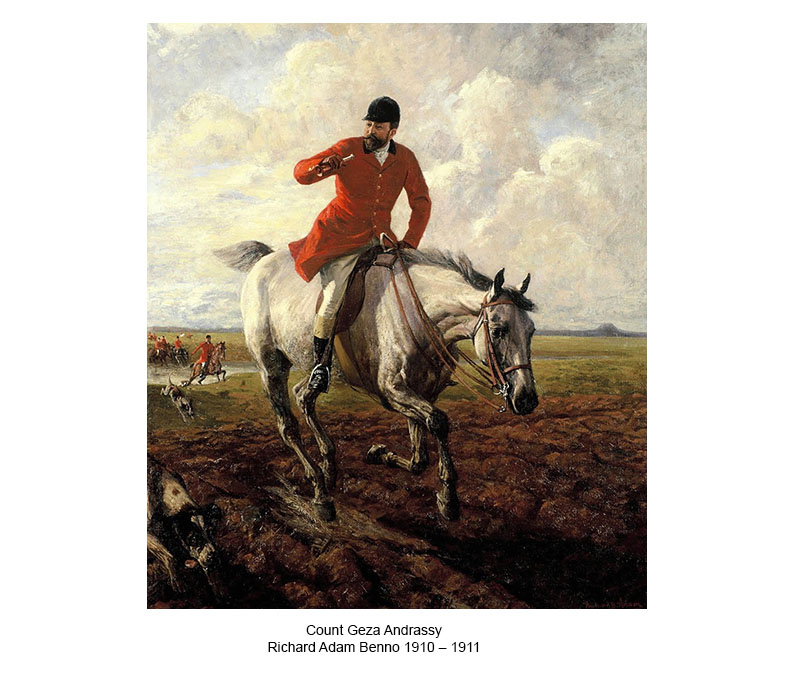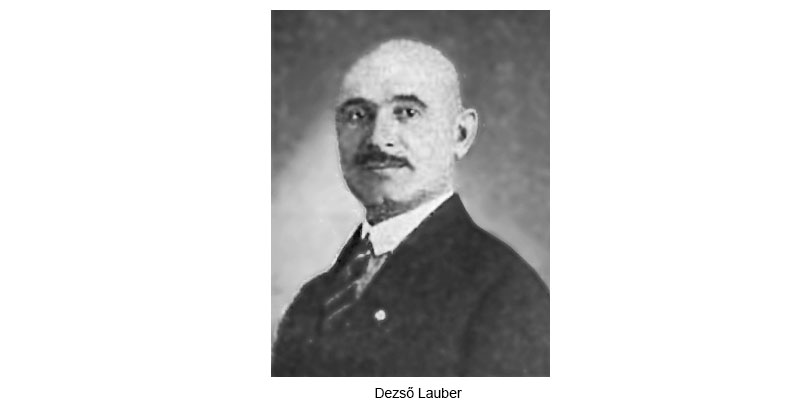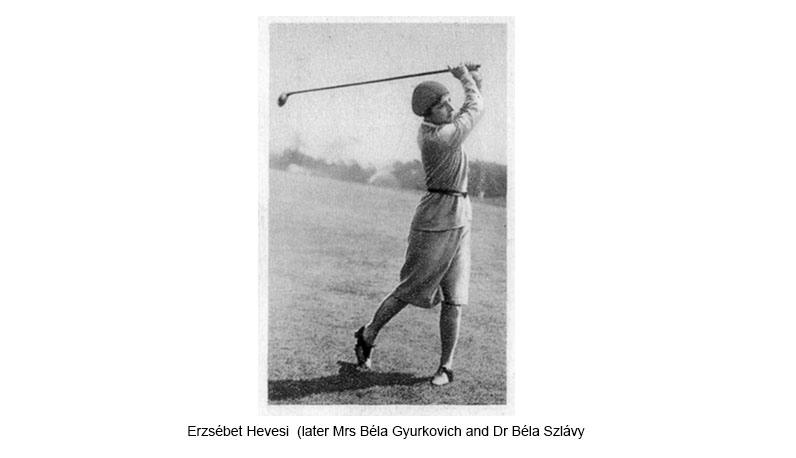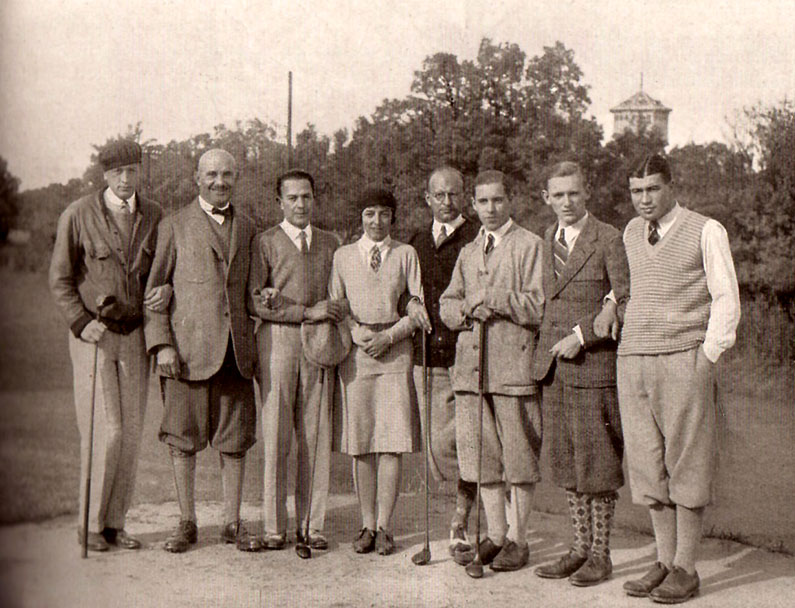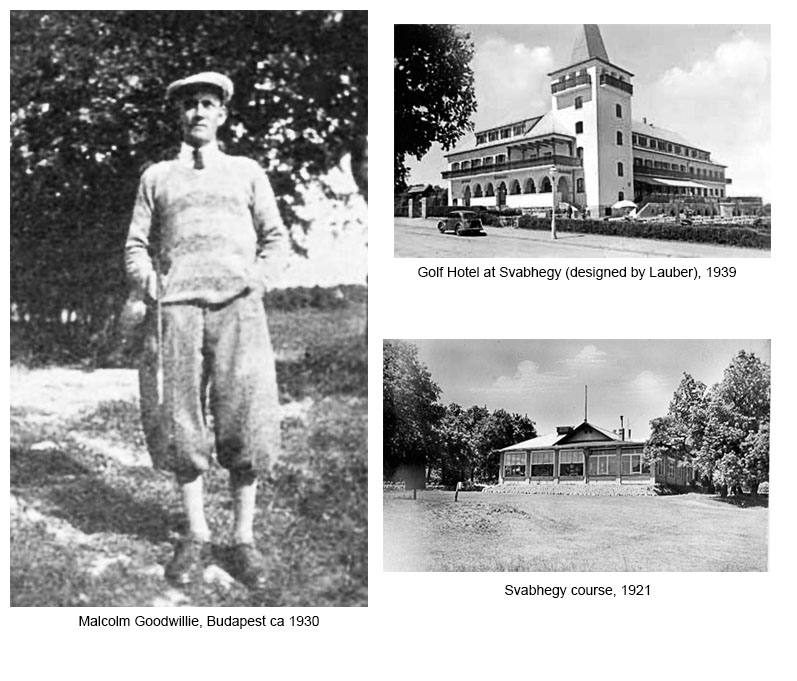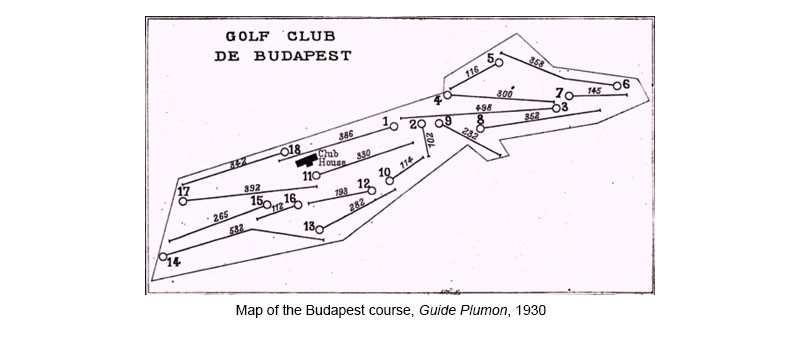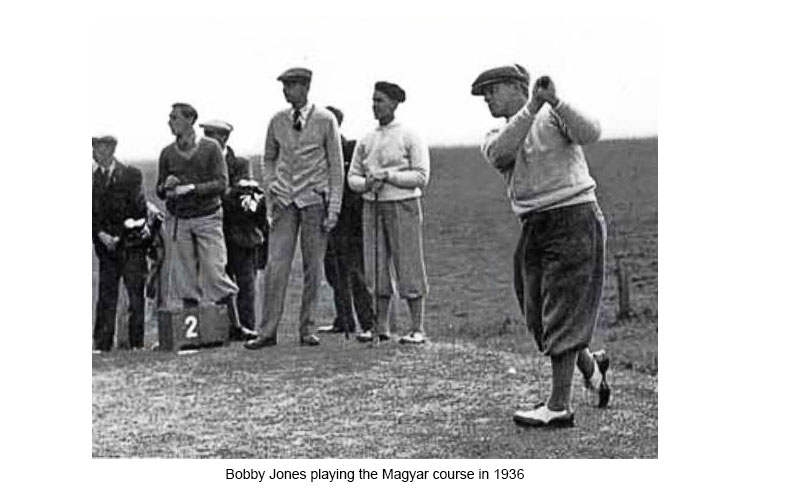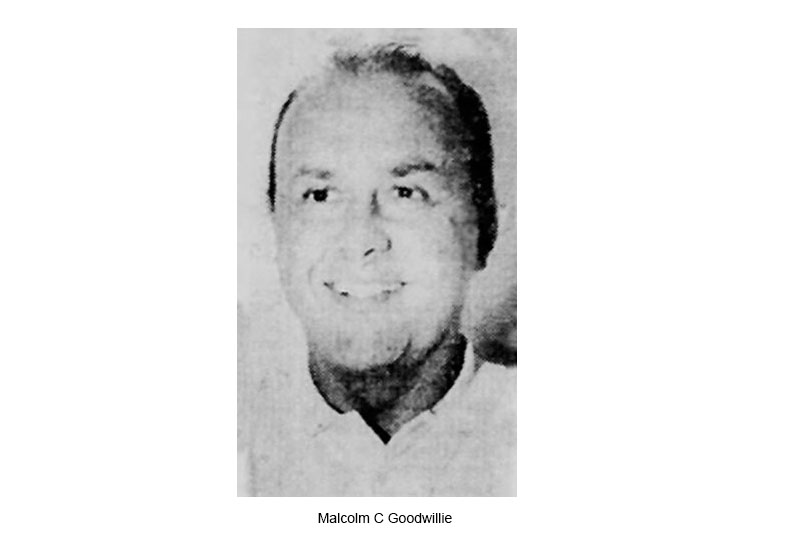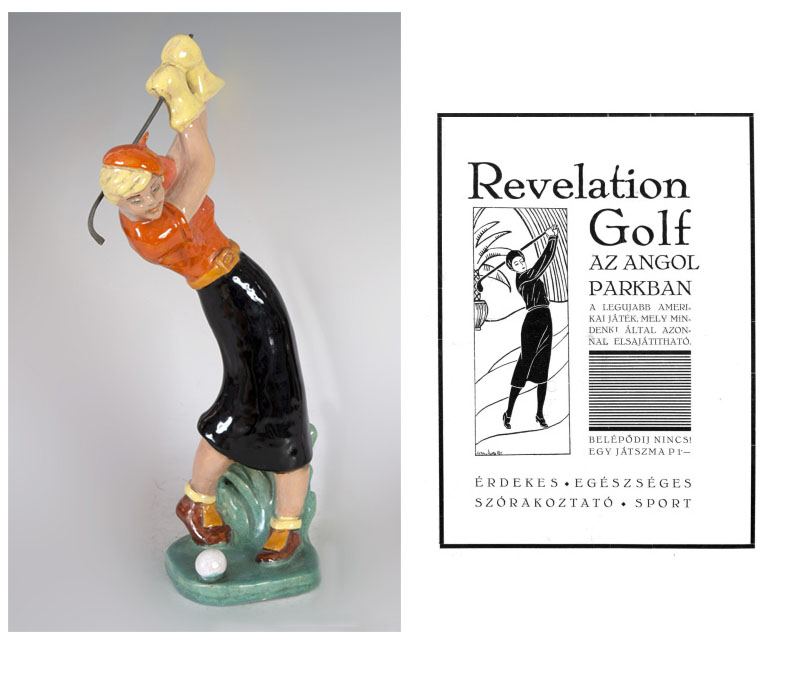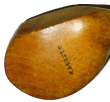
|
Registration Edit profile catalogue auction shopping cart shipping history makers search faq news links about contact |

Scottish Golf History
PlacesGolf in Hungary: The Leven Connection(Source: © 2023, Douglas MacKenzie FSAScot) A version of this article is published in Golfika, 31, Spring/Summer 2023
It should come as no surprise that golf was adopted relatively early in Hungary. Throughout the 19th century, and particularly after the influence of Stephen Széchenyi there was an ‘anglomania’ abroad in the country influencing, among other things, architecture, gardens, literature, sports and fashion1. George Cecil, writing in Golf noted that ‘from speaking English and wearing clothes with the stamp of Savile Row upon them, to golf was but a skip’2.
The first demonstration of golf in Hungary was given on the Budapest horse racing course on 13 December 19023. The man to swing the clubs was Count Géza Andrássy, a good friend of the Duke of Windsor, and whose penchant for British sports and pastimes is evident from the 1910 painting of him by Richard Adam Benno. A lawyer who had studied in Budapest, Geneva and the United States, and owner of the Andrássy Ironworks, he was a supporter of many sports and served as President of the Hungarian Athletic Club. He was also the President of the Hungarian Olympic Committee between 1905 and 1927 and a member of the International Olympic Committee.
I have not found an eyewitness account of the event but according to the Hegylakó article the audience ‘really liked the show’ and the British Military Attaché was consulted on course design4. However, that article associates this with, and jumps immediately to, the construction of the Budapest course which was not for another nine years. It (and the earlier Cecil article) ignores the building of the first course in Hungary on the estate of Count Sándor Nákó at Tátralomnic in September 1907 and with which Colonel R Williams was indeed involved5,6. The pivotal figure in this was another all-round sportsman and Hungarian Olympian, Dezső Lauber. Secretary of the Hungarian Olympic Committee, he represented Hungary at tennis in the 1908 Olympics. Apart from his golfing achievements described below, he also competed internationally in bobsleigh, skating and cycling. Conveniently he was also an architect (he won a silver medal for a stadium design at the 1924 Olympics) and designed the Tátralomnic course7,8. He was also secretary of the club which held its first five day championship over the nine-hole circuit beginning on 11 August 19099. Each day featured a different format, beginning with a stroke handicap competition won by Barclay Rives of the US Embassy. Lauber himself triumphed in the stroke competition on the second day and the competitions continued with matchplay, an open scratch competition and concluded with a fourball10.
The next Hungarian golfing venture was in the capital. Local sources suggest because both Andrássy and Lauber were frequently in Budapest on national athletic or Olympic business they felt the need for a golf course there. George Cecil waxed rather more lyrically on the development. ‘(in 1911) the Budapest athletes sang the praises of the “Royal and Ancient” and during a certain supper party during which the tokays of the country flowed, plans for a club and links were drawn up …. There arose the question of a site. “Our cooking arrangements,” quoth the host of the occasion, “are complete. None more so. But where will the hare be?”The club was formed on 7 June 1911 with Andrássy as president and Lauber as secretary. Cecil’s account, though, has missed out another step, the first incarnation of the Budapest course. Indeed a course was formed on Széchenyi-hegy (also refered to as Svábhegy), designed once again by Dezső Lauber but on land leased from Albert Déczi. Competitions were played there in 1912, its articles of association were approved the following year and a Frenchman, Jean-Pierre Lafitte, employed as professional. He did not provide satisfaction and his stay was short. Baron Károly Hatvany personally enticed Malcolm Goodwillie, of whom much more later, to the club12. Some sources claim the Hungarian championship was played there in 1912, won by by Dr László Magyar and in 1913 when it was won by Dezső Lauber though others treat these as ‘unofficial’ championships13. A third course was opened in Hungary in 1914 in the spa town Pőstyén and private courses were established by the rich beside their castles and manor houses at Martonvásár, Fót, Zichyújfalu and Alag14. Golf largely had to be put on hold during the First World War. The course at Tátralomnic was destroyed during the war and both it and Pőstyén were on land given to Czechoslovakia on its independence in 1918. Déczi, the landowner for the Budapest club’s course, died during the war and no agreement regarding the lease was reached with the heirs. As a result the Budapest Golf Club was dissolved. A new club, the Magyar Golf Club, was formed, again with Andrássy and Lauber at the helm15. This is when Artur Kánitz stepped in, bought the land and gifted it to the golf club. Lauber had to flee Budapest but returned after the war and reconstructed the Budapest course. It was in good enough shape to stage the Hungarian championship in 1920. George Cecil16 described the nine-hole 2500 yard course as ‘an extraordinarily sporting one’, ‘lying 1200 feet above sea level. From most parts of the links an extraordinarily fine view of the Danube may be had as it winds through woodland’. Most of the fairways were tree-lined and the greens surrounded by groups of trees. ‘At the fifth green (280 yards, bogey 4) the drive is made from the tee over a traverse line of trees 80 yards in length. At the seventh green (140 yards, bogey 3) another wood intervenes while the 8th (400 yards, bogey 5) is as tricky as any.’‘The course is an uncommonly puzzling one,’ he concludes. Although on a hilltop plateau it was close to the centre of Budapest, twelve minutes by car according to Cecil, or a fifteen minute walk from the station at Fogaskerek? and also served by a cog-wheel railway for the less energetic. As was the case in neighbouring countries, Austria, Romania, Czechoslovakia as it was then, early Hungarian golf was a pastime for the rich and titled and many club members were British and American expatriates17. Unlike its neighbours though, during the 1920s Hungary produced its own native players of international calibre. The winner of that 1920 championship was Béla Gyurkovich and he and Lauber dominated the championship from then until 1941 with ten wins for Lauber and three for Gyurkovich with only János Hatvany and Dr Jenő Kovács of native players interrupting these results. International success began as early as 1913 when Dezső Lauber went to Vienna and defeated all the Austrian golfers to capture the Joseph von Flesch trophy18. Both Dezső Lauber and Jenő Kovács won the Austrian championship and Lauber won the Adriatic Championship at Brioni in 192919 and 193020.
If this seems like domination on the male side it pales into insignificance when women players are considered. Erzsébet Hevesi won the first officially sanctioned ladies’ championship in 1921. Under this, her maiden name, and then as Mrs Béla Gyurkovich and later Mrs Dr Béla Szlávy she won another 17 national championships up to 1941 despite a brief retirement in 1929. Sometimes she faced only two competitors in the ladies’ competition but in 1920, when there was no ladies’ competition at all, she was allowed to enter the men’s competition. She defeated Lauber in the matchplay and lost to Gyurkovich in the final. In 1922 she was again allowed to compete in the men’s tournament and again lost to Gyurkovich in the final. In 1929 she played in the closed championship of Hungary, finishing second to Lauber and ahead of her ex-husband Gyurkovich21,22. Once more, in the absence of a ladies’ championship, she competed in the open competition of 1937 and won. She too demonstrated her skill abroad winning the German championship in 1926 (though the Deutscher Golf Verband has decided to only recognise titles from 1927 onwards) 23 and had five wins in the Austrian championship and four Czechoslovak titles.
In addition to individual triumphs, before tournament golf took up all the playing dates, international team golf was a feature in Europe. These were typically bilateral events, Hungary faced Germany eight times in the 1920s with, of the known results, three wins apiece and one all-square24. As the picture below shows, Mrs Szlávy competed against the men here also. There were also multi-team events, the largest of the period (though greatly reduced because of withdrawals on account of the political situation) was the Great Golf Prize of Nations25 at Baden Baden just after the 1936 Berlin Olympics. The event, in what was to become the Canada Cup format, won by an English pair representing Great Britain, attracted six visiting national teams including Hungary with, almost inevitably, Lauber in its pairing26.
Hungary v Germany 1928: Dezső Lauber 2nd from left, Mrs Béla Szlávy 4th; I believe Béla Gyurkovich far left and Dr Jenő Kovács third from left
The Hungarian Golf Association graciously acknowledges the role of its ‘foreign trainer’ in developing these players. Though the first identification of him I found27 gets his name wrong and, to add insult to injury, describes him as English. This trainer was Malcolm Goodwillie28, professional at the Magyar Golf Club in Budapest. Born in Leven, Fife on 18 January 1885, the son of David Goodwillie, an insurance agent, and his wife Georgina née Brand29, he began his working life as a miner, employed as a drawer, responsible for pushing the tubs of coal from the coal face to the bottom of the shaft. He was a good amateur player in the Leven Thistle club. Playing at Burntisland in the Scottish Amateur Championship of 1906 he was drawn against James Sorley30, another Fifer destined to be a professional in eastern Europe (Carlsbad in Sorley’s case). From Leven Thistle Goodwillie won the Shepherd Cup 31 and the Innerleven Gold Medal (the Leven Links Championship) in 190732. The following year, after playing in the Scottish amateur at Leven he turned professional and although a later newspaper report suggests he was a ‘golf tutor’ at Wemyss Castle33 his first real post was in 1908 at the newly established club at Selsey near Chichester34. In November 1912 he accepted the position of professional at Burgess Hill35. He had played in the Open Championship of 1910 at St Andrews but a first round 98 following a thunderstorm so severe that the course flooded and the round replayed (and far from the worst score, there were six rounds of 147) meant he missed the cut after the second round36. There was a similar outcome, minus the deluge, at the 1911 Open held at Royal St George’s37. His stay at Burgess Hill was short (though long enough to play George Duncan in a match to mark the opening of the extended course winning the first medal round and losing the second in matchplay38), his appointment to the Budapest club being announced in September 1913 with Goodwillie leaving for Hungary immediately39. He took with him, as assistant, his younger brother, Charles. The brothers were soon caught up with the First World War as enemy non-combatants and technically were interned. To use the word internment obviously had some propaganda value40 but the arrangement was far looser. Interviewed when back in Fife for a holiday in 1930 he said, ‘he was by no means interned and could move about freely and unchallenged so long as he confined himself to the city’s environs. Of the treatment meted out to him then he speaks very highly’41.If he bore the Budapest club any ill-will, when in September 1919 they asked him to return they also asked him to bring £2000 of golfing requisites with him which made the deal even sweeter42. He accepted with alacrity. For all the success he had in coaching in the 1920s he bemoaned the costs involved in golfing in Hungary. ‘All the courses are excellent 18 hole stretches but owing to the climatic conditions huge bills for upkeep make the charge for a round so restrictive that the game is as yet largely the preserve of the aristocracy. A common enough fee for membership is £40 and many of the clubs fix a yearly subscription of nearly 50 guineas [£52 10s] 43.’He argued that the costliness of the game was militating against the youth of the country participating because when a man was able to take up the game he was usually well on in years with no hope of ever striking championship class. These prices were phenomenal. To put them into context, back in Fife the Golf House Club Elie (to which villagers were often hostile because of its high charges compared to other local clubs) in the early 1920s imposed a £3 3s joining fee and an annual subscription of £2. It was not all teaching for him in the 1920s. First there was sadness. Charles took a trip home to Fife in 1922 and did not return. He succumbed at the age of 27 to double pneumonia after catching influenza44. James, another brother, went to Budapest as Malcolm’s assistant in 1929 promptly setting a new course record of 6545.
In 1924 the Golf Championship of Central Europe was played over the Magyar course. After four rounds, with a score of 312, Goodwillie was the winner, sixteen strokes ahead of his nearest rival, the German, Stiefler46. The following year the championship was played in Bad Salzbrunn in Silesia and Goodwillie went to defend his title. There were only two rounds this time and he finished third behind Marsh (presumably H Marsh who came from the Disley club in Stockport to become professional at Wentorf-Reinbek club outside Hamburg) and Hanton (E R Hanton who became pro at Leipzig later in the decade) who tied for first47. He qualified and played in the 1927 German Open at Berlin Wannsee which attracted a strong field, qualifying behind Percy Alliss, Archie Compston and Open champions Henry Cotton and Arthur Havers but ahead of Ted Ray and George Duncan48.
1933 marked Goodwillie’s 20 years with the club and the members presented him with an illuminated address signed by the secretary and president49. In September 1935 the Prince of Wales (later briefly King Edward VIII then Duke of Windsor) visited the course and Malcolm Goodwillie partnered him during his round50. Royalty of a different kind visited the course the following year in the shape of Bobby Jones who had been invited to the celebration for the 25th anniversary of the club’s founding. Malcolm was star struck. He did not know what Bobby Jones looked like but knew he would recognise him by his clubs when he got off the train. When no one left the train with clubs he was disappointed and asked a gentleman who looked American, “Forgive me sir but did Bobby Jones, the great golfer, come on the train with you?” In a quiet voice the stranger replied, “I’m Bobby Jones51.” Goodwillie offered to help him to his hotel but was too nervous to invite him to play golf but, just as he was leaving, Jones asked him if he might have a set of clubs he could borrow and came to the club for a game with him. A very nervous Goodwillie had to be reassured by his small son to ‘just play his normal game’. Nervous as he was, he seemed to remember every shot Bobby Jones played. He described Jones topping his drive on the 7th tee. The first hundred metres is just a tangle of stones, weeds and rough grass and Jones’ ball lay in a cluster of rocks and bushes. “I’ll never forget him walking up to it. He stood looking at the ball for a minute and scratching his head and pushing his cap back and forth. Then he pulled a brassie out of his bag, took one more quick look and banged that bloody ball 225 metres straight up the hill. There’ll never be another like him52.”The finest golf shot of all time was Goodwillie’s verdict.
The Hungarian Golf Federation is wrong in saying he went back home to “England” after the club closed in 194353. Exactly how he spent the rest of the war is not clear. None of his relatives in Scotland had heard from him since 1942 but in October 1945 they received news through the Red Cross that he and the family were safe54. Probably having had enough of European wars and internment he, his Hungarian wife Mária née Götz55 and younger son, David James, emigrated to the United States in May 1947 aboard the Marine Flasher from Le Havre to New York City56 and settled in Vermont. That same year Malcolm became a naturalised American citizen. He does not appear to have had any further connection with professional golf: the 1950 US census lists him as a caretaker and his wife’s obituary in 199257 notes the couple had run Goodwillie’s Country Store in Manchester, VT. He died in Manchester on 9 November 195958 and was buried with his favourite 7 iron. This apparently was a club he had been about to sell to a customer but took a fancy to its balance and kept it. In later life he used it as a walking stick59. The Goodwillies’ elder son Malcolm Charles, born in 1923, was the first Hungarian born player to enter the Boys’ Championship, travelling from Budapest to play at Moor Park in 193860. If later newspaper articles about his life are correct he turned professional in 1941. This was presumably in Europe as he first travelled to America to rejoin his parents and brother in 1953 aboard the Île de France from Le Havre, the manifest showing his last place of residence as England61. A newspaper article in 1964 noting his appointment as professional at the Quarry Hill club in South Burlington 62 states he had been professional at the Dover Hill club in Manchester, VT, for eight years. Mentioning also a prior stint at Stratton Mountain GC, in 1966 Malcolm jnr became professional at Oakwood63. By the time of his mother’s death in 1992 he was back living in Hungary (see below)64.
Despite golf being very much a minority sport in Hungary (the PA reporter who wrote the Bobby Jones story reported a membership in Budapest of ‘a few Americans from the Legion and a dozen more Englishmen and some 50 Hungarians’) it must have impinged in some way on the popular consciousness. Komlos Keramia, who initially operated from Nyíregyháza but later opened a factory in Budapest, produced this 33cm high art deco female golfing figure between 1931 and 1934 65. Indeed golf in Hungary during the 1930s seemed to have more affinity with art deco than other sports, the French and American association perhaps, as demonstrated by the 1931 advertisement 66.
From being excluded from international sport after World War I, including Budapest losing the 1920 Olympics it had been awarded and, indeed, Hungary not even being invited to the Antwerp games67, Hungary in the 1930s had once again joined the European sporting family. In golf this manifested itself in Hungary being a founder member of the European Golf Assocation established in Luxembourg in November 1937 with the country’s delegate being who else but Dezső Lauber68. Of course, soon after, Europe turned to things other than golf. After the war the communist regime in Hungary was keen to use sport as a political tool but not golf which was seen as a capitalist recreation with golf club members likely to be exposed to “imperialists’ recruitment activities” and the Magyar Golf Club was dissolved in 195169. There were various alternating periods of détente and hostility towards golf until 1979 when Dr Ferenc Gáty established the Blue Danube Golf Club and became its first president. He had been a soil expert in Cuba with UNIDO for four years and fallen in love with golf there. Seeking permission to build the course, the local party secretary took the attitude that if golf was good enough for Comrade Castro it’s good enough for us. Gáty became president of the newly-constituted Hungarian Golf Federation when it was created in 198970. Golf in Hungary was properly back. And in a nice completion of the circle when the Szentlőrinc club was established just outside Budapest in 1992 their ‘chief trainer’, with a focus on talented young players, was Malcom C Goodwillie71 nearly 80 years after his father began at the Magyar Golf Club. As is the case with everything I write which touches on Central European golf, my thanks to Christoph Meister for finding additional relevant records and photographs. REFERENCES AND FOOTNOTES
1 “Anglomania” in Hungary, 1780-1900, László Orzságh, Angol Filológiai Tanulmányok / Hungarian Studies in English, Debrecen, 12 (1979), pp. 19-36 |
site design dmc ltd | © 2000-2024 Antique Golf Clubs from Scotland
